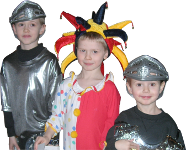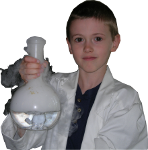Make Way for Ducklings
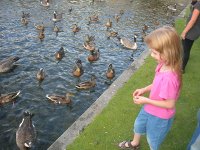 Whenever we need to get out of the house and relax for a bit, we go to a nearby pond or lake to feed the ducks. Sometimes geese or other birds are floating on the water, and we can identify what they are. One time we saw an osprey swooping down out of the air and grabbing a fish right out of the water with its talons! What a sight! Other birds fly through the air, and if you look through a pair of binoculars, you can see what type of food they are eating. Some birds fly with their mouths open, and they catch many insects that hang out over stagnant water. Others are carnivores, and you can tell by how they rush down to grab some helpless mouse or other animal scampering through the tall grass a little ways from the pond.
Whenever we need to get out of the house and relax for a bit, we go to a nearby pond or lake to feed the ducks. Sometimes geese or other birds are floating on the water, and we can identify what they are. One time we saw an osprey swooping down out of the air and grabbing a fish right out of the water with its talons! What a sight! Other birds fly through the air, and if you look through a pair of binoculars, you can see what type of food they are eating. Some birds fly with their mouths open, and they catch many insects that hang out over stagnant water. Others are carnivores, and you can tell by how they rush down to grab some helpless mouse or other animal scampering through the tall grass a little ways from the pond.
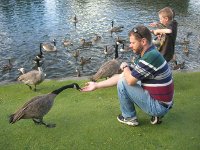 I usually put bread heels into the freezer, and over time, the bag gets full. If you take the bread out of the freezer the day before, this is ideal. Otherwise, if you are going on the spur of the moment, just throw the bread on a plate and press defrost on your microwave. Don't leave it in too long. It will thaw out the rest of the way by the time you arrive at the pond.
I usually put bread heels into the freezer, and over time, the bag gets full. If you take the bread out of the freezer the day before, this is ideal. Otherwise, if you are going on the spur of the moment, just throw the bread on a plate and press defrost on your microwave. Don't leave it in too long. It will thaw out the rest of the way by the time you arrive at the pond.
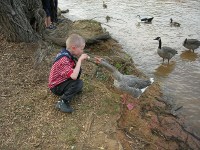 The children enjoy being popular with wild birds that come up to them. Some will even take food out of a child's hand. The children enjoy breaking off pieces and tossing them into the water. Sometimes a duck will catch the bread in its mouth before it even touches the water. The children giggle when this happens.
The children enjoy being popular with wild birds that come up to them. Some will even take food out of a child's hand. The children enjoy breaking off pieces and tossing them into the water. Sometimes a duck will catch the bread in its mouth before it even touches the water. The children giggle when this happens.
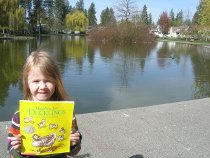 One fun book to read to your children before feeding the ducks is Make Way For Ducklings, by Robert McCloskey. The story is a classic, as the ducks are trying to make a home for themselves in a city. We have the book on cassette, and the younger children like to listen to the story as they turn the pages. I remember when I was in eighth grade, my art teacher opened this book and had us try to imitate the beautiful pencil sketches without tracing them. I still have one of my sketches, which came out very well, considering that I'm not an artist.
One fun book to read to your children before feeding the ducks is Make Way For Ducklings, by Robert McCloskey. The story is a classic, as the ducks are trying to make a home for themselves in a city. We have the book on cassette, and the younger children like to listen to the story as they turn the pages. I remember when I was in eighth grade, my art teacher opened this book and had us try to imitate the beautiful pencil sketches without tracing them. I still have one of my sketches, which came out very well, considering that I'm not an artist.
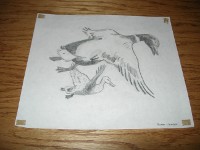 Last time we went to the pond, I saw a long-necked bird. It was a blue heron! I absolutely love long-necked birds because they look so exotic. (It reminds me of when I traveled to Egypt.) When I looked through the binoculars, I saw that it had made a nest on an island in the middle of the pond, very similar to the ducks in Make Way for Ducklings. I was enchanted.
Last time we went to the pond, I saw a long-necked bird. It was a blue heron! I absolutely love long-necked birds because they look so exotic. (It reminds me of when I traveled to Egypt.) When I looked through the binoculars, I saw that it had made a nest on an island in the middle of the pond, very similar to the ducks in Make Way for Ducklings. I was enchanted.
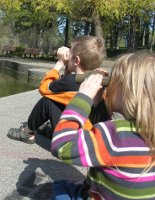 For so little effort, you can do nature study with your children if you take out some nature notebooks and have them draw or write what they see. A set of colored pencils will add dimension to their picture. On the way back home you can grab some books about ducks and ponds from the library. Or if you're like me, you can find some books on your own shelves at home. Then the children can browse through the books and learn more, just by looking at the pictures or reading the books on their own if they are older.
For so little effort, you can do nature study with your children if you take out some nature notebooks and have them draw or write what they see. A set of colored pencils will add dimension to their picture. On the way back home you can grab some books about ducks and ponds from the library. Or if you're like me, you can find some books on your own shelves at home. Then the children can browse through the books and learn more, just by looking at the pictures or reading the books on their own if they are older.






